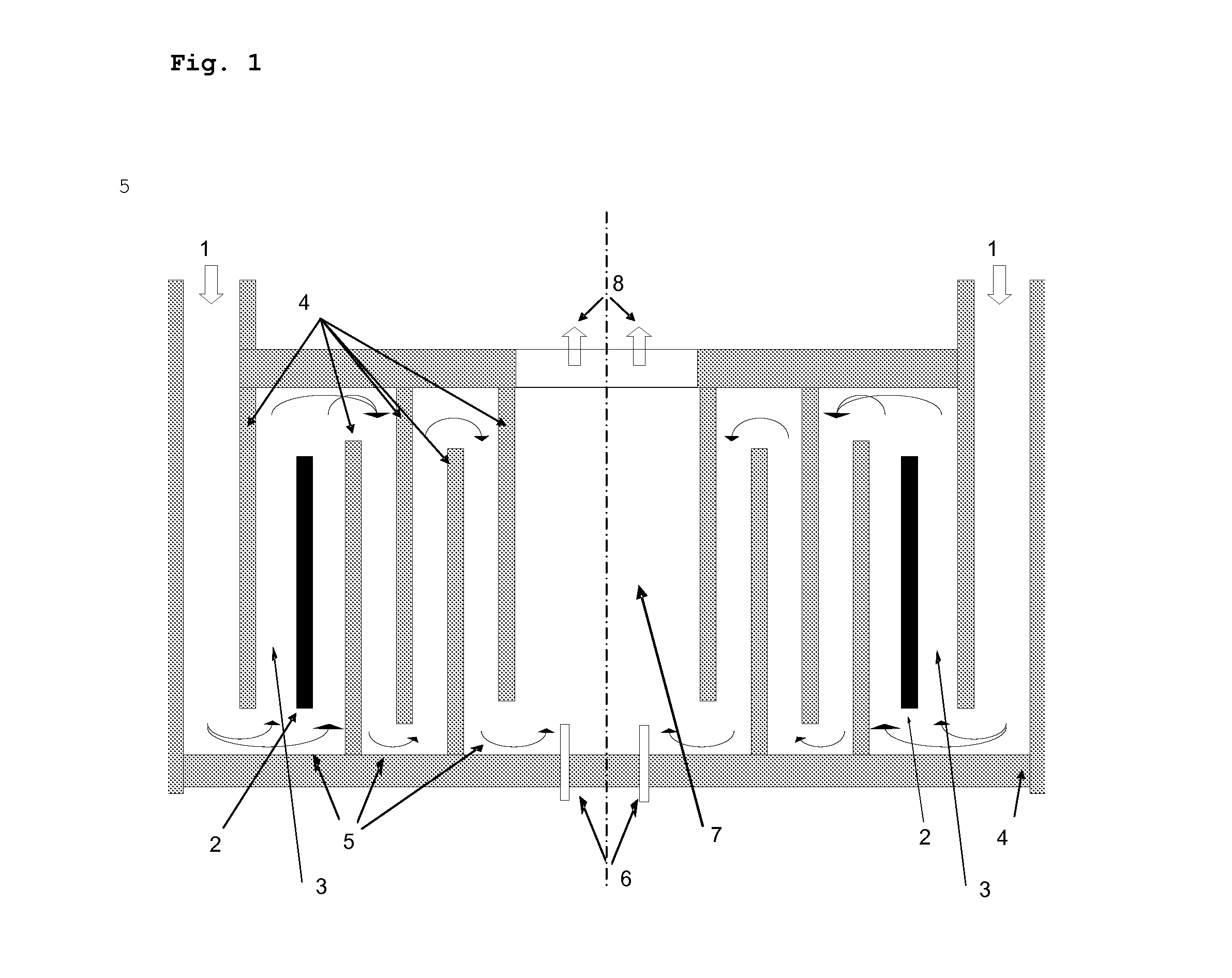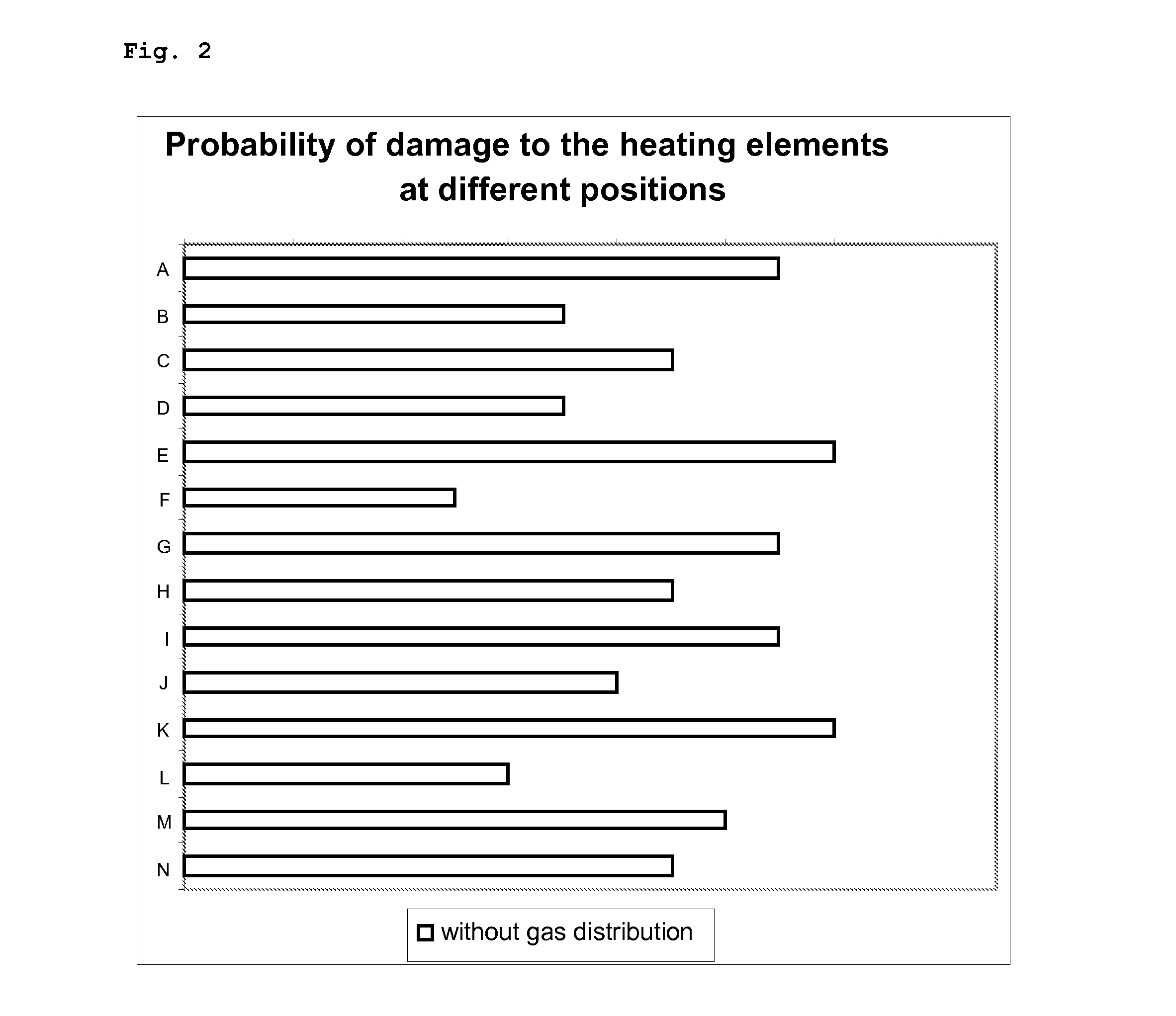Reactor and process for endothermic gas phase reaction in a reactor
a gas phase reaction and reactor technology, applied in the direction of instruments, silicon compounds, disinfection, etc., can solve the problems of long-term failure of the reactor, and high construction complexity
- Summary
- Abstract
- Description
- Claims
- Application Information
AI Technical Summary
Benefits of technology
Problems solved by technology
Method used
Image
Examples
example 1
Comparative Example
[0073]For the comparative example, a reactor according to U.S. Pat. No. 4,536,642 was used.
[0074]A gas mixture in the reactant stream consisting of 33 mol % of silicon tetrachloride and 67 mol % of hydrogen was used. The inlet temperature of the reactant gas stream was about 175° C.
[0075]The pressure was set to 6 bar and the temperature of the gas in the reaction zone to 1000° C.
[0076]After the reaction, the product gas was analyzed in a gas chromatograph, and the proportions of trichlorosilane and silicon tetrachloride were determined. The temperature of the exiting product gas stream was about 350° C.
[0077]The relative selectivity is given by the molar proportion of trichlorosilane relative to silicon tetrachloride.
[0078]For the sake of simplicity, the relative selectivity attained in the comparative example is defined as 100% if all heating elements are working.
[0079]FIG. 2 shows the relative probability of damage to the individual heating elements as a functio...
example 2
[0085]In Example 2, essentially the same boundary conditions are used as in Example 1.
[0086]However, the gas supply is distributed better into the heating zone using a gas distribution apparatus.
[0087]The gas distribution apparatus homogenizes the gas stream fed in over different gas passage dimensions along the gas feed into the cylindrical heating zone.
[0088]FIG. 3 shows a distinct improvement in the probability of damage resulting from the incorporation of a gas distribution apparatus.
[0089]The random cases of damage are altered to become a systematic distribution.
[0090]FIG. 3 additionally shows an inhomogeneous but systematic distribution of the gas phase supplied.
[0091]The relative probability of damage to the heating elements is reduced and the reactor can be operated for longer.
[0092]By virtue of the now systematic gas distribution, it is possible by further optimization steps to adjust and further improve the apparatus for better gas distribution according to the geometry of...
example 3
[0099]In Example 3, essentially the same boundary conditions are used as in Example 1.
[0100]However, the reaction zone is equipped with an additional four temperature measurement devices, such that it is possible to additionally measure the temperature in the reaction zone in a spatially resolved manner.
[0101]The temperature measurement devices are arranged radially around the centre of the base plate within the reaction zone.
[0102]FIG. 1 shows, by way of example, the position of two of these additional temperature measurement devices 6.
[0103]If the determination of the temperature is carried out not as described in Example 1 with only one temperature measurement device but with the mean of all the values from the available temperature measurement devices, it is found that, in the event of failure of a heating element, the relative selectivity falls only to 99.5%, since the direct influence of temperature on the regulation temperature is reduced.
[0104]The unwanted by-products from a...
PUM
| Property | Measurement | Unit |
|---|---|---|
| temperature | aaaaa | aaaaa |
| temperature | aaaaa | aaaaa |
| temperature | aaaaa | aaaaa |
Abstract
Description
Claims
Application Information
 Login to View More
Login to View More - R&D
- Intellectual Property
- Life Sciences
- Materials
- Tech Scout
- Unparalleled Data Quality
- Higher Quality Content
- 60% Fewer Hallucinations
Browse by: Latest US Patents, China's latest patents, Technical Efficacy Thesaurus, Application Domain, Technology Topic, Popular Technical Reports.
© 2025 PatSnap. All rights reserved.Legal|Privacy policy|Modern Slavery Act Transparency Statement|Sitemap|About US| Contact US: help@patsnap.com



